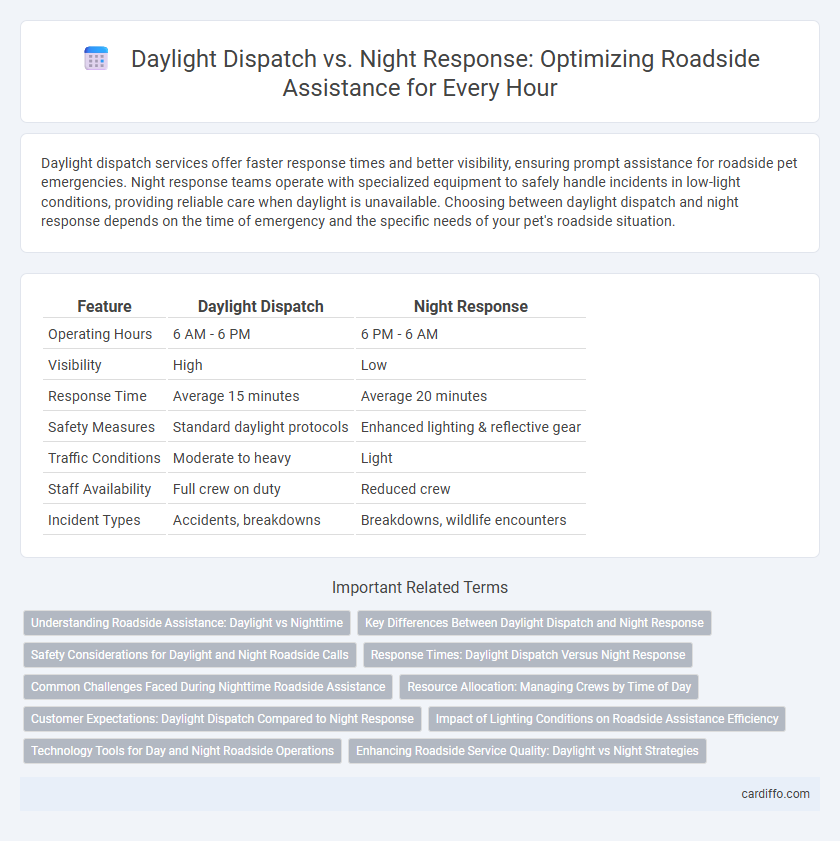Daylight dispatch services offer faster response times and better visibility, ensuring prompt assistance for roadside pet emergencies. Night response teams operate with specialized equipment to safely handle incidents in low-light conditions, providing reliable care when daylight is unavailable. Choosing between daylight dispatch and night response depends on the time of emergency and the specific needs of your pet's roadside situation.
Table of Comparison
| Feature | Daylight Dispatch | Night Response |
|---|---|---|
| Operating Hours | 6 AM - 6 PM | 6 PM - 6 AM |
| Visibility | High | Low |
| Response Time | Average 15 minutes | Average 20 minutes |
| Safety Measures | Standard daylight protocols | Enhanced lighting & reflective gear |
| Traffic Conditions | Moderate to heavy | Light |
| Staff Availability | Full crew on duty | Reduced crew |
| Incident Types | Accidents, breakdowns | Breakdowns, wildlife encounters |
Understanding Roadside Assistance: Daylight vs Nighttime
Roadside assistance response times and service availability vary significantly between daylight and nighttime hours due to factors such as traffic density and workforce shifts. Daylight dispatch often benefits from faster arrival due to higher visibility and more readily available service providers, while nighttime response can face delays caused by reduced staffing and safety concerns. Understanding these differences helps in setting realistic expectations and choosing appropriate roadside assistance plans tailored to specific time-based needs.
Key Differences Between Daylight Dispatch and Night Response
Daylight dispatch operations benefit from better visibility, allowing quicker identification of roadside hazards and more efficient vehicle recovery compared to night response. Night response requires enhanced safety protocols, including high-visibility gear and additional lighting equipment to manage limited visibility and increased risk from passing traffic. Response times may vary as night operations often face slower navigation and greater reliance on technological aids like thermal imaging and GPS tracking.
Safety Considerations for Daylight and Night Roadside Calls
Daylight dispatch offers improved visibility for both responders and drivers, significantly reducing the risk of accidents during roadside assistance compared to night response. Enhanced natural lighting allows for better hazard identification, safer vehicle positioning, and quicker assessment of the scene. Night roadside calls require high-visibility clothing, reflective signage, and strong artificial lighting to mitigate increased dangers from reduced visibility and impaired driver perception.
Response Times: Daylight Dispatch Versus Night Response
Daylight dispatch typically achieves faster response times, averaging 15 minutes due to improved visibility and resource availability. Night response times often extend to 25 minutes or more, influenced by limited personnel and reduced traffic conditions that complicate navigation. Efficient roadside assistance relies on optimizing these temporal factors to ensure timely aid regardless of the hour.
Common Challenges Faced During Nighttime Roadside Assistance
Nighttime roadside assistance often encounters reduced visibility, making vehicle diagnostics and repairs more difficult compared to daylight dispatch. Limited ambient light increases the risk of accidents and slows response times due to the need for additional safety precautions. Emergency crews face challenges in locating stranded vehicles and assessing hazards, impacting the efficiency of night response operations.
Resource Allocation: Managing Crews by Time of Day
Daylight dispatch allows for more efficient resource allocation by maximizing visibility and leveraging larger crews during peak hours, improving response times and job completion rates. Night response requires specialized teams with enhanced safety equipment and lighting to navigate reduced visibility and increased hazards, often resulting in smaller, highly trained crews. Balancing crew size and expertise based on time of day ensures optimal roadside assistance performance and efficient use of resources.
Customer Expectations: Daylight Dispatch Compared to Night Response
Customer expectations for daylight dispatch emphasize faster arrival times and increased visibility, enabling more efficient roadside assistance and safer service. Night response demands heightened communication and reassurance due to limited visibility and potential safety concerns, prompting customers to expect thorough updates and professional handling. Service providers must tailor their approach to these differing expectations to enhance overall customer satisfaction and trust.
Impact of Lighting Conditions on Roadside Assistance Efficiency
Daylight dispatch significantly improves roadside assistance efficiency due to enhanced visibility, allowing technicians to quickly assess situations and perform repairs safely. Night response presents challenges such as reduced visibility and increased risk, extending response times and complicating diagnostics. Effective lighting conditions directly influence technician safety, accuracy, and overall service speed during roadside emergencies.
Technology Tools for Day and Night Roadside Operations
Daylight dispatch leverages advanced GPS tracking and mobile communication apps to enhance real-time coordination and vehicle location accuracy for swift service. Night response relies heavily on infrared cameras, thermal imaging, and automated alert systems to ensure safety and rapid incident detection in low visibility conditions. Both operations integrate cloud-based platforms to streamline workflow and maintain seamless communication between drivers and dispatchers regardless of the time.
Enhancing Roadside Service Quality: Daylight vs Night Strategies
Daylight dispatch improves roadside service quality through increased visibility, faster response times, and enhanced communication with drivers, enabling safer and more efficient vehicle recovery. Night response requires specialized equipment and trained personnel to navigate reduced visibility and heightened safety risks, demanding rigorous protocols to maintain service excellence. Balancing these approaches involves leveraging daylight advantages for routine operations while optimizing night strategies for emergency incidents, ensuring consistent roadside assistance quality around the clock.
Daylight Dispatch vs Night Response Infographic

 cardiffo.com
cardiffo.com